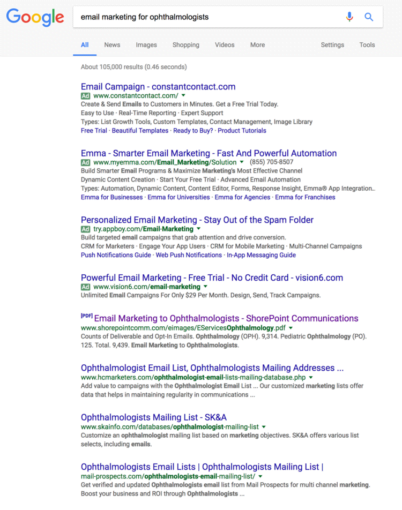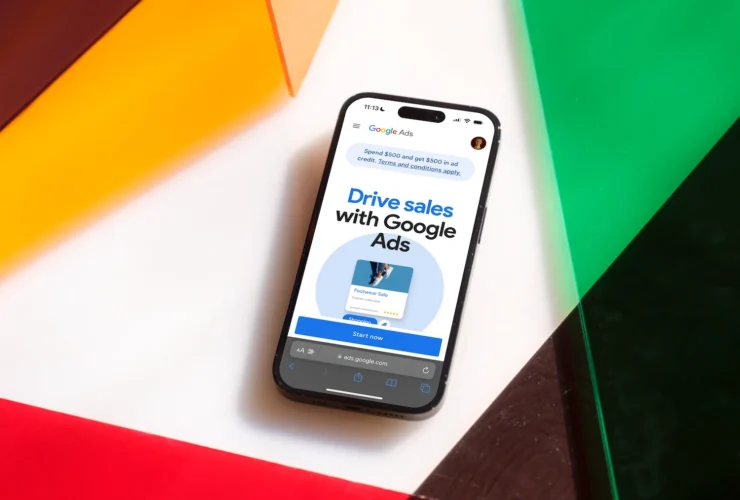How NOT to do Ophthalmic Practice Marketing
I got an email today advertising “LASIK SPECIAL – ACT NOW!”
My spam filters usually catch these overt advertisements before they get through to my inbox, and the ones that do get deleted immediately. I’m highly myopic, so I could probably benefit from LASIK…but I don’t want to learn more about LASIK from a spammy email.
Nevertheless, I opened this email, because, well, I wanted to see how bad it was. Let me show you:
 There are several problems with this email. In no particular order…
There are several problems with this email. In no particular order…
- It’s mostly an image – no real text in it at all. Not only will Google flag you for this type of email behavior, but it’s terrible user experience. The text that is there is 100% white (to blend in with the background of the email).
- The email address it’s being sent from? LASIK.Vision.@wiqgzttliapbmgk.com. That just screams authenticity, doesn’t it?
- For advertising LASIK, isn’t it a little strange that THE GIRL IS WEARING GLASSES?
Those are just a few silly examples of why this email is obviously spam and doesn’t deserve my attention. But sadly, it’s become characteristic of the ophthalmic market. Over the years, we’ve seen countless examples of spammy emails trying to market ophthalmic services, but none actually get patients’ attention.

It’s led us to the realization that email lists don’t work.
Too many ophthalmologists and marketing directors think that purchasing massive email lists or scraping email addresses in plain text from websites is an effective way of marketing their services.
They’re wrong. If you want to reach those who need your services most, you’re going to need to adopt a new mindset.
A New Way of Marketing
Just like any other business, ophthalmology practices have been impacted by the changing landscape of marketing, which is pushing them to embrace new methods of connecting with patients.
While email (done correctly) is an effective tool for engaging with patients, there are some other strategies that deserved your marketing director’s attention.
Email and Content Marketing
When it comes to digital marketing, content is king. If you really want your marketing to have an impact, you need really great content – and lots of it. The great news about creating content is that if it’s written and researched well, it can serve you as “evergreen” content (or content that can be re-purposed and shared multiple times via different channels, such as email newsletters, on your blog, via social media, etc).
In order to be truly useful, your content has to be well-written and relevant for your audience – you can’t just churn out content and hope to have an impact.
Don’t be afraid to write content for multiple “buyer personas,” or potential patients that may be at different stages of their journey. Some patients have already decided that they will have LASIK surgery this year and are merely looking to research providers, while others are a bit more hesitant and need more information.
Writing content to educate patients at varying stages of the buyer journey is a great strategy, as it can help patients engage with you no matter where they are.
No More Email Lists – Choose a Newsletter Instead
We mentioned that large email lists don’t work – a better tactic is to create an email newsletter that you send regularly (once a week, once a month, etc) that educates patients and offers incredible value for them.

While creating good content is a challenge for most ophthalmic practices, it’s worth the investment. Research says you should see substantial results – for every $1 spent on email marketing, the average return is $44.25.
Email newsletters can be a great way to build stronger relationships with your patients. Never underestimate the power of connection – research suggests that it takes an average of seven “touchpoints” with a brand for us to feel connected, familiar, and comfortable with that brand. The more “connected” a potential patients feels towards your practice, the more likely they will be to choose you when considering ophthalmic surgery…and an email newsletter is a great way to stay connected.
Search Engine Optimization (SEO)
Referrals and word of mouth are great marketing tactics, but no amount of referrals can beat the power of the Internet. 89% of patients will do a Google search before ever picking up the phone or coming in for a visit, so it’s vital to have good SEO strategies in place on your website.

Google’s algorithms have gotten smarter in recent years, so in addition to SEO, you’ll want to make sure your website is mobile-friendly as well.
It’s these factors that make good SEO more important than ever. Your practice website should be optimized for keywords, contain descriptions for each page and blog post, and have a sitemap listed with Google so they can know to keep indexing your site.
Pay-per-click (PPC) advertising
Pay-per-click, or PPC advertising, consists of ads that you only pay for when a user clicks on it. Instead of paying for people to see your ad, you’re essentially buying visits to your website. Popular PPC platforms include Google AdWords and Bing and Yahoo ads. To make sure that you’re getting the most bang for your buck, it’s a good idea to be on all three.

With PPC campaigns, you can set maximum ad spends so your budget doesn’t get out of control, and you have lots of information at your fingertips. While PPC costs more than social media marketing and content marketing, you have control and analytics for everything – it’s an essential piece of your practice’s marketing strategy.
Social Media Marketing
Social media marketing should be a vital element of your practice’s marketing strategy – if it isn’t, you’re missing out on powerful opportunities to connect with patients and educate them on your offerings, frequently asked questions, and more.
Many people think they have to be on every single social media platform…and that’s just not true. While you don’t need to be absolutely everywhere (does anybody actually use Google+?), you should pick a few social media platforms that you keep fresh and regularly engage with patients.
Not sure what to post? Try some of these:
- Answer frequently asked questions. “What can I expect after surgery?” “Does LASIK hurt?” Giving answers to these questions and directing potential patients towards your website can be a powerful tool to generate more business.
- Highlight patient successes and testimonials (and get them on video if you can!). People love seeing and sharing life-changing stories, so if you have patients who want to share their experiences, capitalize on it!
- Go behind-the-scenes at your practice, giving patients a unique glimpse into everyday life. Use social media as a tool to let patients get to know your doctors, office staff, and your office itself. Live streaming apps like Facebook Live, Periscope, and Instagram stories can be effective tools for this as well.
Public Relations
In today’s digital landscape, the most effective way to get results from your PR efforts is to use both traditional and digital PR.
On the traditional side of PR lies local broadcast, print, and trade publications, which can produce great local results. And as for digital PR, you’d be dumb to not include it as part of your marketing plan. The ROI on digital PR is huge – and the results last longer than traditional PR. Getting your business into publications and trade journals (especially those with accompanying online resources) is a must if you want to grow your practice.
All of these PR activities increase your authority as a thought leader in your field, which not only serves to earn patients’ trust, but also tells Google that you’re an authority on your subject, which helps with search engine rankings.
What’s Your Marketing Plan Look Like?
Are you utilizing these marketing strategies in your practice? Are your current strategies not yielding results? Contact us for a free audit of your marketing and get a leg up on the competition.








